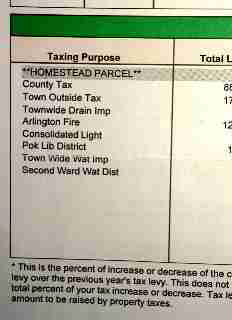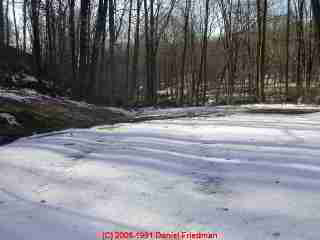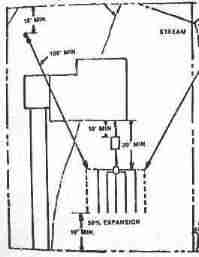 How Do We Find Out if a Building is Actually Connected to a Sewer System - or to a Septic Tank?
How Do We Find Out if a Building is Actually Connected to a Sewer System - or to a Septic Tank?
- POST a QUESTION or COMMENT about how to figure out if a home is connected to public sewer or private septic
Septic or sewer connection determining by clues:
\This article what clues can confirm that a building has actually been connected to a public sewer, or on the contrary, that it is connected to a private septic tank system. In the previous section of this article we explained how to determine whether or not a public sewer is available at a property.
Here we continue by discussing how to find out if a particular building has actually been connected to an available sewer main.
A reader asked, "How do I know if the house I am purchasing has a septic tank?"
Even if a sewer is installed right in the street in front of a building, that building may never have been connected to the sewer line. Here are some clues that help sort out this question.
InspectAPedia tolerates no conflicts of interest. We have no relationship with advertisers, products, or services discussed at this website.
- Daniel Friedman, Publisher/Editor/Author - See WHO ARE WE?
Clues Indicating That a Building Has Been or Has Not Been Connected to the Public Sewer

No room for septic systems: If lots in the area are very small there may not be room for private septic systems to have been installed in the first place.
Usually we'll find that a public or a community sewer main has been provided and that the closely-spaced homes or cluster homes are connected to that system.
But be careful. In some communities we find that new cluster housing or town houses on a street are all connected to a municipal sewer line, but on the same street a number of older, pre-existing homes are all served by private septic systems.
Look at the size available on the individual lot surrounding the property you are investigating, and consider when that home or building was constructed.
Depressions or cleanout access covers indicating that a septic tank is present (these may be present even if a building was later connected to a sewer, as we discuss further below). Depressions in the ground surface are caused by settlement of softer dirt following an excavation to install or service a septic system component.
These ground settlement marks may be small and round, just a couple of feet in diameter where someone dug up a septic tank cover, they may be larger and round or rectangular up to 6' x 10' if they mark a septic tank outline.
As our photo shows, multiple, long straight parallel depressions in the ground, especially in an area where there are no trees may indicate trenches of a septic drainfield. In winter in areas where snowfall occurs, snow-melt may also mark
a septic tank or drainfield location.

Tax deprtment records and tax bills for a property often indicate a charge for connection to both public water and public sewer lines. But don't count on this data being correct.
Sometimes the tax department thinks the building is connected to a sewer and charges for it but in fact the building was never connected-up to that system.
Tax bills can be confusing to a new homeowner but you may find that the folks at the tax department will be friendly and happy to explain the bill to you. The tax department will show you if your tax bill includes an assessment for sewage services.
Building department records will usually record where sewer lines have been installed and which buildings have been connected to them. Be careful: on occasion we find that those records were mistaken, especially where newer sewer lines and older buildings are involved together.
Drawings and plans: papers describing the building's construction, and even sketches can tell if a septic tank or sewer connection is used for a building.
Often in older properties someone has sketched the distance to a septic tank right on the wall by the exit point of the main drain from the building.
Look there and look overhead among floor joists over a basement or crawl space for a paper that may have been placed there showing the drain destination.
Investigate the existing main drain piping using a sewer line or drain line video camera. A video inspection camera inserted into the sewer or main drain at the buji
See SEWER / SEPTIC PIPE CAMERAS
Neighbors and Contractors: neighbors will have a vital interest in and are likely to know if buildings on the street are connected to a sewer system or to private septic tank systems.
Records of plumbers who worked on the building, or even local septic pumping companies may have records of what type of waste disposal system is at the property
...
Continue reading at GUIDE for BUILDINGS CONNECTED to PUBLIC SEWER or select a topic from the closely-related articles below, or see the complete ARTICLE INDEX.
Or see these
Recommended Articles
- CLOGGED DRAIN DIAGNOSIS
- FIND the SEPTIC TANK, HOW TO
- SEPTIC or SEWER CONNECTION? - topic home
- WHAT TO ASK ABOUT SEWERS or SEPTICS
- CLUES INDICATING A SEWER LINE is PRESENT
- CLUES INDICATING CONNECTED to SEWER
- GUIDE for BUILDINGS CONNECTED to PUBLIC SEWER
- GUIDE for BUILDINGS PRE-DATING SEWER INSTALLATION
- GUIDE for BUILDINGS CONNECTED to PRIVATE SEPTIC
- WHAT TO DO IF NO ONE KNOWS - if the connection is to sewer or septic
- SEPTIC VIDEOS show how to walk the site for possible septic tank & drainfield locations
- SEWER / SEPTIC PIPE CAMERAS
Suggested citation for this web page
CLUES INDICATING CONNECTED to SEWER at InspectApedia.com - online encyclopedia of building & environmental inspection, testing, diagnosis, repair, & problem prevention advice.
Or see this
INDEX to RELATED ARTICLES: ARTICLE INDEX to SEPTIC SYSTEMS
Or use the SEARCH BOX found below to Ask a Question or Search InspectApedia
Ask a Question or Search InspectApedia
Try the search box just below, or if you prefer, post a question or comment in the Comments box below and we will respond promptly.
Search the InspectApedia website
Note: appearance of your Comment below may be delayed: if your comment contains an image, photograph, web link, or text that looks to the software as if it might be a web link, your posting will appear after it has been approved by a moderator. Apologies for the delay.
Only one image can be added per comment but you can post as many comments, and therefore images, as you like.
You will not receive a notification when a response to your question has been posted.
Please bookmark this page to make it easy for you to check back for our response.
IF above you see "Comment Form is loading comments..." then COMMENT BOX - countable.ca / bawkbox.com IS NOT WORKING.
In any case you are welcome to send an email directly to us at InspectApedia.com at editor@inspectApedia.com
We'll reply to you directly. Please help us help you by noting, in your email, the URL of the InspectApedia page where you wanted to comment.
Citations & References
In addition to any citations in the article above, a full list is available on request.
- New York State Department of Health, APPENDIX 75-A WASTEWATER TREATMENT STANDARDS - INDIVIDUAL HOUSEHOLD SYSTEMS , [PDF] New York State Department of Health, 3 February 2010, retrieved 3/1/2010, original source: https://www.health.ny.gov/regulations/nycrr/title_10/part_75/appendix_75-a.htm
- SEPTIC TANK/SOIL-ABSORPTION SYSTEMS: HOW TO OPERATE & MAINTAIN [PDF] - , Equipment Tips, U.S. Department of Agriculture, 8271 1302, 7100 Engineering, 2300 Recreation, September 1982, web search 08/28/2010, original source: http://www.fs.fed.us/t-d/pubs/pdfimage/82711302.pdf.
- Advanced Onsite Wastewater Systems Technologies, Anish R. Jantrania, Mark A. Gross. Anish Jantrania, Ph.D., P.E., M.B.A., is a Consulting Engineer, in Mechanicsville VA, 804-550-0389 (2006). Outstanding technical reference especially on alternative septic system design alternatives. Written for designers and engineers, this book is not at all easy going for homeowners but is a text I recommend for professionals--DF.
- Builder's Guide to Wells and Septic Systems, Woodson, R. Dodge: $ 24.95; MCGRAW HILL B; TP; Quoting from Amazon's description: For the homebuilder, one mistake in estimating or installing wells and septic systems can cost thousands of dollars. This comprehensive guide filled with case studies can prevent that. Master plumber R. Dodge Woodson packs this reader-friendly guide with guidance and information, including details on new techniques and materials that can economize and expedite jobs and advice on how to avoid mistakes in both estimating and construction. Chapters cover virtually every aspect of wells and septic systems, including on-site evaluations; site limitations; bidding; soil studies, septic designs, and code-related issues; drilled and dug wells, gravel and pipe, chamber-type, and gravity septic systems; pump stations; common problems with well installation; and remedies for poor septic situations. Woodson also discusses ways to increase profits by avoiding cost overruns.
- In addition to citations & references found in this article, see the research citations given at the end of the related articles found at our suggested
CONTINUE READING or RECOMMENDED ARTICLES.
- Carson, Dunlop & Associates Ltd., 120 Carlton Street Suite 407, Toronto ON M5A 4K2. Tel: (416) 964-9415 1-800-268-7070 Email: info@carsondunlop.com. Alan Carson is a past president of ASHI, the American Society of Home Inspectors.
Thanks to Alan Carson and Bob Dunlop, for permission for InspectAPedia to use text excerpts from The HOME REFERENCE BOOK - the Encyclopedia of Homes and to use illustrations from The ILLUSTRATED HOME .
Carson Dunlop Associates provides extensive home inspection education and report writing material. In gratitude we provide links to tsome Carson Dunlop Associates products and services.



